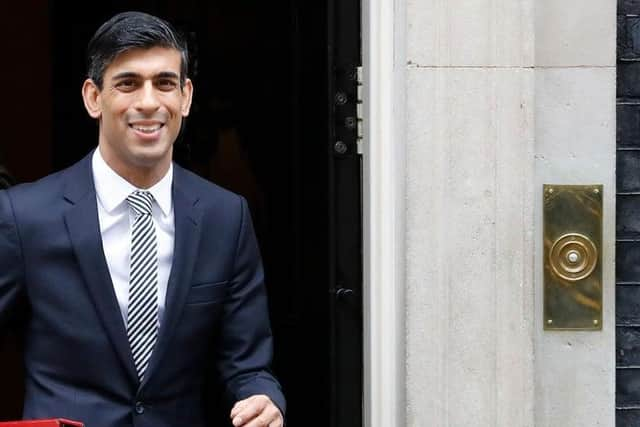Bill Jamieson: How the budget unleashed a tsunami of money not experienced in UK finance
Chancellor Rishi Sunak’s Budget did not just sound the death knell for austerity. It unleashed a tsunami of money not experienced in UK finance.
From emergency measures to help households and businesses, the lifting of the threshold for National Insurance, through action to ease bank lending to stricken firms, to business rate relief and substantial extra funding for the NHS and social care services – an £18 billion coronavirus-combating stimulus in all – seldom has a Budget opened so many spigots at once to release a foaming torrent of finance.
Advertisement
Hide AdAdvertisement
Hide AdAnd all this heralded by the halving of interest rates from 0.75 per cent to 0.25 per cent by the Bank of England to equal their lowest level on record. In a deluge of measures lasting more than an hour, ranging over all manner of infrastructure projects and cash boosts from investment through further education, the Chancellor has re-written the UK Budget history books.


He did so by performing a double somersault through Conservative orthodoxy, commanding the Commons like some super-energised acrobat in Strictly Come Dancing. The party that relentlessly insisted that only a decade of austerity would return the economy to health and was the only way forward did not just acquiesce in all this but cheered their dynamic cartwheeling Chancellor to the echo.
As if the spending brew was not powerful enough, the Chancellor threw in sweeteners – not lifting the freeze on fuel duty for example despite the slump in oil prices bringing cheaper petrol to the pumps, and foregoing excise duty rises on spirits, wine and beer.
With a total stimulus package running to £30bn, and with £175bn in new spending pledged over five years, we have now embarked on the biggest surge in borrowing in living memory, made possible by ultra-low interest rates and with no apparent change in UK debt interest costs: truly a miracle that has eluded all previous chancellors.
Now come the searching questions. Will all the measures announced to counter the coronavirus slowdown really work?
It’s impossible to say until we know the duration of the epidemic and its peak.
Many of the measures announced are intended to counter the impact of up to one in five of the UK workforce falling sick.
But this is not a medicine that will ensure their health or effect quick recovery for those who fall sick.
Advertisement
Hide AdAdvertisement
Hide AdAnd it will not replace the countless service sector functions and activities now suffering a devastating slump in their revenues. That money is lost forever. From a curb on public gathering to cancelled travel and holiday bookings, thousands of companies are unlikely to recover, however generous the parachutes. Understandably missing from yesterday’s Budget was the traditional presentation of economic forecasts for each of the next five years. The figures presented – of growth slowing from 1.4 per cent to 1.1 per cent this year – are “pre coronavirus” and largely academic until we know more. But a hit there most certainly will be, not least because global growth will also be slower – from 2.9 per cent to 2.4 per cent on OECD forecasts.
How effective will the infrastructure spending prove?
The Office for Budget Responsibility estimates that the Chancellor’s measures will result in a 2.5 per cent lift in long-term productivity. But the sums involved are colossal, there are questions as to how quickly so much can be disbursed and much depends on that contribution to productivity for the money to be spent sensibly and well. Examples abound of massive over-spends and project delays – the Crossrail link being a prime example. And then there is the money question: from where is all this cash coming, and is it sustainable? There is no doubt that lower interest rates worldwide and lower debt servicing costs have enabled the Chancellor to pursue a £100bn lift to borrowing without bond investors heading for the hills.
Debt interest costs are forecast to remain relatively quiet at around £35bn – well down their level in the immediate aftermath of the banking crisis.
But in the event of a post-virus rebound in the late summer encouraging hopes of a “V” shaped recovery, interest rates may well be forced up – and with it our debt interest bill.
But the biggest changes may not come until the Autumn Statement in November when the Chancellor has completed a review of the problematic fiscal rules. Under the current regime, the government is allowed to borrow up to 3 per cent of GDP for investment while borrowing for current spending is due to be reduced to zero in 2022-23.
But the current spending rule fails to take account of the current economic circumstances – especially in the wake of the coronavirus epidemic. Even before this, the Treasury’s record on these rules is dismal. The Institute for Fiscal Studies estimates that there have been more than 16 fiscal targets announced over the past decade. And ten of the 12 fiscal rules adopted between 1997 and 2016 were subsequently missed or abandoned. Some fresh and radical thinking to this pivotal feature of the UK Budget is certainly overdue here.